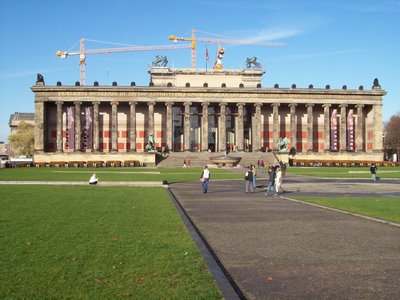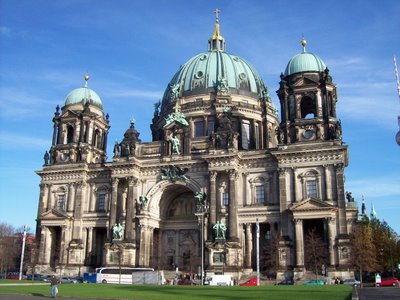Berlin I



I spent our Thanksgiving break in Berlin. I have not been in the capital since 2000 when I made a couple of day trips from nearby Wittenberg. I stayed at a hostel in the “mitte” or middle section of Berlin which is actually in the former east Berlin. It was a rather upscale hostel, filled with students but also some more mature travelers. I had a nice single room on the sixth floor with my own tiny bathroom and shower. Even had maid service every other day. The place, an A&O Hostel, must be packed during the summer. They also have branches in Prague and Hamburg.
The afternoon I arrived, the weather was cold and rainy. Surprisingly, the next day dawned sunny and warm. I almost didn’t need my jacket. I went to the nearby subway stop, named after the famous German poet Heinrich Heine, and went off to Alexander Platz. From there I walked past the Berlin Rathaus, known as the Red Rathaus because of its red brick construction. Nearby was an interesting church called Marienkirch which had largely survived the bombing and fighting during the war. From there I walked along to a small mall where I stopped at a coffee shop and had a cup at a sidewalk table in the warm sunshine. Then it was off to see the nearby Berliner Dom, a beautiful cathedral that my guidebook said is proof that Protestants, too, can build an extravagant place of worship. Instead of saints adorning the beautiful doorway, there are small statues of prominent figures of the Reformation. Above at bottom is a photo of the Dom along the River Spree which flows through the city.
Next it was off to the city’s island on the Spree, known as the Museumsinsel, or museum island, a treasure trove of museums, After a sandwich and a pint of Berliner pilsner for lunch at a museum cafe, I decided to see the Alte Nationalgalerie, a musem of nineteenth century art (primarily German); and the Pergammon, a world-famous archaelogical museum. One of the important aspects of the Alte Nationalgalerie is that its main reason for being was to be an expression of German identity and German nationalism. While the Germans are an ancient people, the German state is only a creation of the mid-nineteenth century, a product of the nationalism that swept Europe after the Napoleonic conquests and of Otto von Bismarck’s military conquests between 1866 and 1871. So the goal was to be a showplace of German art. It is a great collection. For me, one of the highlights is the famous painting of Prussia’s Frederick the Great, who was a musician as well as a military commander, playing the violin for his court. A photo of the Alte Nationalgalerie in above in the middle.
Next, it was on to the Pergamon. The museum gets its name from the huge temple that German archaelogists uncovered at the site of the ancient Greek town of Pergamon. This Altar of Zeus, photo above, is the first thing one seems on walking into the musem. Spectacular. There are rooms and rooms full of Greek and Roman sculpture, even the famous Roman copy of a copy of a bust of Alexander the Great that appears in most books about Alex. One floor of the museum focuses just on Islamic art, reaching back to the first caliphate and going on through the Ottomans. But the most impressive thing for me was Babylon’s Ishtar Gate. Taken brick by brick from the site of ancient Babylon, the gate was reconstructed in the museum. Large parts of it had to be created new because of missing pieces but nevertheless the gate stands inside the museum as you can see in the photo. Amazing. Photos can’t do it justice. At the top, is a shot of the Egyptian museum which I did not visit on this trip.

0 Comments:
Post a Comment
<< Home